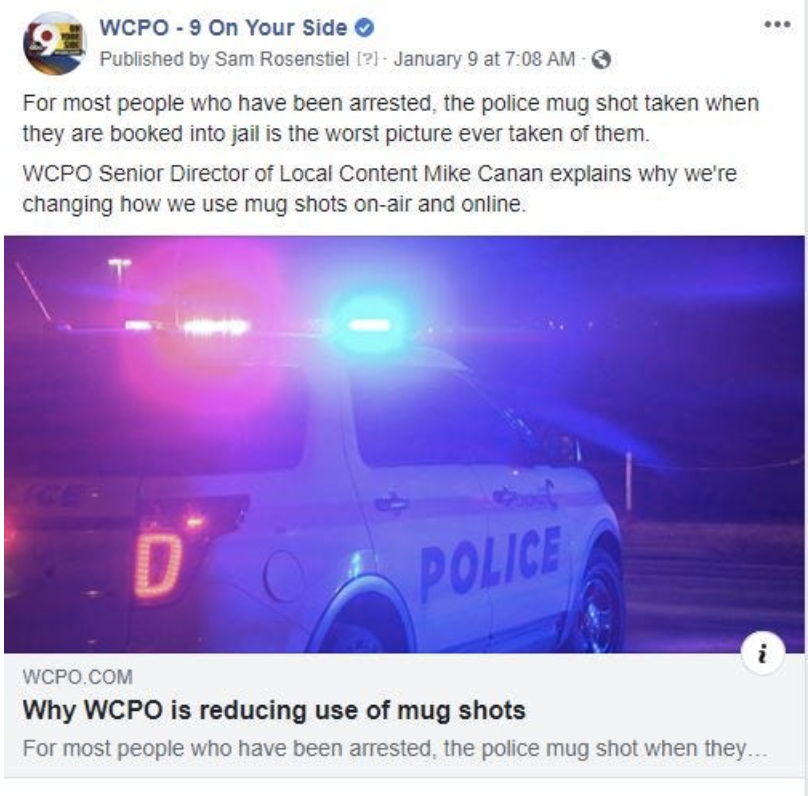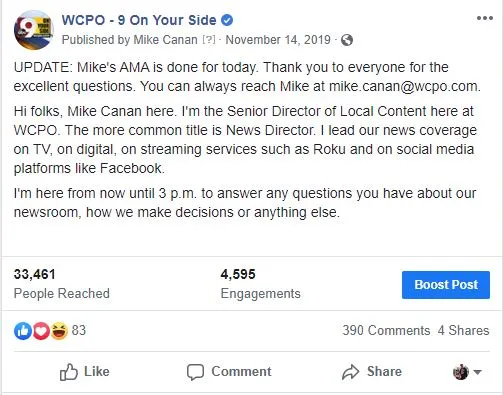
Here’s how partner station WCPO got on the record about the changes they made to their mugshot policy with their audience — on air and online.
We changed our approach to using mug shots online and on-air then told our community why
Last summer as part of our station’s efforts to examine our policies — especially when it comes to how we cover minority communities — our team at WCPO decided to make a drastic change when it comes to airing and publishing police mug shots.
The policy had been in place for three months, and I don’t think anyone had even noticed the change.
But then I wrote a column and the feedback poured in.
Our new policy is to generally only use mug shots in the following situations:
- The person police suspect of the crime is still on the loose. We have the person’s past mug shot and it is important that our audience know what the suspect looks like because he or she is at large and may be a danger to the public.
- Police have arrested a suspect, but officials believe there could be additional victims. It is important to show the public what this person looks like so others could determine if they were a victim of the same person.
We made this change to our policy for two primary reasons: the potential for mug shots to reinforce racial stereotypes and suspects that don’t meet the above criteria can be haunted for years after their mug shot is published/aired for a minor crime.
We soft-launched the policy in early September but waited several months before making the sharing the changes with the public. I wanted to make sure the policy didn’t have unintended consequences before we made any promises about what we were doing.
Mostly making the change was not difficult for our staff. I heard from more and more staff members that even if they had initial concerns, they now agreed with the policy. Many said they felt like the policy made sense or at the very least not using the mug shots wasn’t hurting our ability to cover the news in our community.
Once our team reaffirmed that the policy was on target, we decided to communicate the mug shot policy to our audience.
The column
The goal of communicating the change was to be transparent with our community.
We wanted people to know what we were doing and why. We knew that many people hadn’t noticed the change. We also wanted to make sure that anyone who noticed that we were no longer using mug shots understood why we made that decision. We did not want anyone to make assumptions.
On Jan. 9, we published a column I had written about the policy and immediately the feedback poured in.
In more than 20 years as a reporter, editor and news leader, I have written hundreds of articles and columns. I received more feedback on this mug shot column than anything I have ever written. The feedback varied by platform.
Twitter was mostly positive.

Facebook was fairly evenly divided between people who supported our policy and people who were against it.


I received more than 75 emails. In the first two days, 90% of those emails were supportive. Over time, we received more negative responses. But still, the responses via email and phone were mostly supportive.
I tried to respond to as many messages as possible — whether those folks supported our decision or not.
Some of the responses were incredibly thoughtful.
One woman wrote: “When I started to look at myself and my racial bias, I realized how seeing all those mug shots has affected me subconsciously. You are doing a real service to humanity by making this decision.”
One retired journalist wrote: “It is all too rare that journalists examine their methodology, and this is a fine example.”
Another wrote about how her mug shot had haunted her: “I appreciate this gesture as I was wrongly accused of a crime and my mug shot was passed around (Facebook) and it was the worst picture of myself and my reputation was ruined. I was assumed guilty because of it I looked like hell. I’ve not recovered from this ugly picture.”
The most encouraging email I received came from a high school senior. She wanted a little more information from me because she is working on a school project on how African Americans are portrayed in the media. Her goal now is to see if she can get other news stations to adopt our policy.
Despite the backlash, be brave
But there is no doubt our policy is controversial.
There are people who disagreed with our decision. I’m sure some people won’t watch us on TV anymore or visit our website after hearing about how we made this change.

One man left me a voicemail. He said that if the mug shots were not included he would not be watching us anymore. I tried to call him back but never reached him. If I did, I would have asked him if he had noticed that we had been following this policy for the last three months.
Despite those calls, I stand by our decision.
And whether the audience will support your policies or not, the more I experiment with transparency, the more I believe it is essential.
If I had never written about our policy, there is a great chance many people would not have noticed the change. Those that did might not have understood the reasoning; I would rather someone understand our thought process and disagree with our decision than simply guess why we made a change.
So my advice is: If you have a policy change, tell your audience. Even if it could be controversial.
Mike Canan is the Senior Director of Local Media Content at WCPO and an original partner with Trusting News. Contact him at mike.canan@wcpo.com. Follow him on Twitter or Instagram at @Mike_Canan.
At Trusting News, we learn how people decide what news to trust and turn that knowledge into actionable strategies for journalists. We train and empower journalists to take responsibility for demonstrating credibility and actively earning trust through transparency and engagement. Subscribe to our Trust Tips newsletter. Follow us on Twitter and LinkedIn. Read more about our work at TrustingNews.org.

Mike Canan
Mike Canan is the Director of Journalism Strategies at the Scripps Howard Foundation and an original partner with Trusting News.
